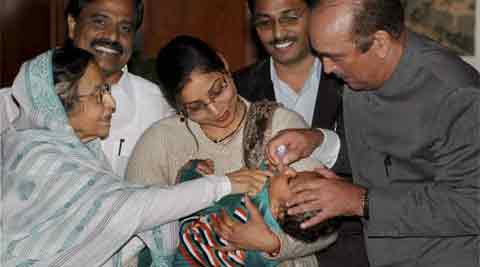Opinion Because we can
India must build on the polio campaign to prioritise childhood immunisation.

 Experts considered India the most technically difficult place to end polio, with migration, high population density and low immunisation coverage. PTI
Experts considered India the most technically difficult place to end polio, with migration, high population density and low immunisation coverage. PTIIndia must build on the polio campaign to prioritise childhood immunisation.
This week, we mark the three-year anniversary of the last case of polio virus in India. It is a monumental achievement — and arguably one of the greatest public health success stories of all time. The legacy of the polio campaign is more than just the successful eradication of the crippling disease. The systems and strategies put in place to reach every child in every part of the country with lifesaving polio vaccines can be used to save millions of children from other preventable diseases.
According to Unicef, every year in India, 1.4 million children under five die from preventable diseases. Reaching every child with timely vaccination could dramatically reduce child deaths in the country. Polio shows that this can be done, if we put our minds to it.
Five years ago, India had nearly half of the world’s polio cases. Experts considered the country the most technically difficult place to end polio, with migration, high population density and low immunisation coverage posing significant challenges. Through the commitment and leadership of the government and with support from national and international partners, over 2.3 million vaccinators immunised 172 million children with the polio vaccine every year. A vast surveillance system was established to allow vaccinators to respond quickly to outbreaks. Strategies were formed to target children in vulnerable communities and other places that were hard to reach.
While we have won the war on polio, we still have a long way to go in combating other childhood diseases that can be prevented with vaccines. Today, we have vaccines that protect against some of the most common childhood diseases. If we can get the polio vaccine to every child, why can’t we do the same with vaccines that protect children against a whole range deadly of diseases?
We need to instil the urgency displayed against polio into the fight against other childhood diseases. While we have made some progress, we are catastrophically off course to meet the UN Millennium Development Goal 4, which calls for reducing child mortality by two-thirds by next year. The national immunisation programme has only 61 per cent coverage across the country. We lag behind many of our neighbours in introducing critical new vaccines into the national immunisation programme, including those to protect against the leading causes of diarrhoea and pneumonia — the two biggest killers of children under five.
India has the opportunity to build on the success of the polio campaign to prioritise childhood immunisation. Polio successes have already contributed to efforts against other vaccine-preventable diseases. For example, the government has implemented a polio-style vaccination campaign in 14 high-risk states against measles, a disease that killed approximately 56,000 children in 2011. Surveillance laboratory systems set up under the polio programme now help monitor for measles outbreaks. Already, large declines in measles cases have been recorded in several states. This is a great step forward and more should be done to leverage the systems and strategies that have defeated polio.
The opposition to efforts to strengthen and expand childhood immunisation, however, poses a real threat. There are some groups that vocally continue to resist vaccination, particularly newer vaccines. Most recently, criticism has stemmed from a small group of doctors that has expressed unfounded scepticism against the five-in-one pentavalent vaccine, despite the vast body of evidence supporting the use of this vaccine. Based on appropriate scientific evidence and recommendations, the government made the decision to introduce the pentavalent vaccine, which protects against diphtheria, pertussis, tetanus, hepatitis B and haemophilus B (Hib), in the national immunisation system. This is an important step towards ensuring that children are protected from life-threatening illnesses, including pneumonia and meningitis caused by Hib.
The Indian Academy of Paediatrics (IAP), an umbrella body of 22,500 paediatricians, and many others supported this long-overdue decision. In fact, during my tenure as IAP president, we released a comprehensive statement condemning the criticism and denounced the attempts to distort facts and create confusion regarding the safety of the vaccine. As medical professionals, we have the responsibility to put children first and use science to inform our decisions. It is time we focused our efforts on ensuring that all children receive scientifically proven vaccines.
The polio campaign has shown the power of vaccines to wipe out a disease and safeguard the future of our children. We can continue to build on the legacy of polio to strengthen routine immunisation. This includes adding new vaccines into the national immunisation system when recommended by the experts. Let the legacy of India’s amazing polio success be that we provide every child in the country with access to lifesaving vaccines and end all child deaths from preventable diseases.
C.P. Bansal
The writer is outgoing president of the Indian Academy of Paediatrics (2013) and president of the South Asia Paediatric
Association (2014-16) express@expressindia.com




